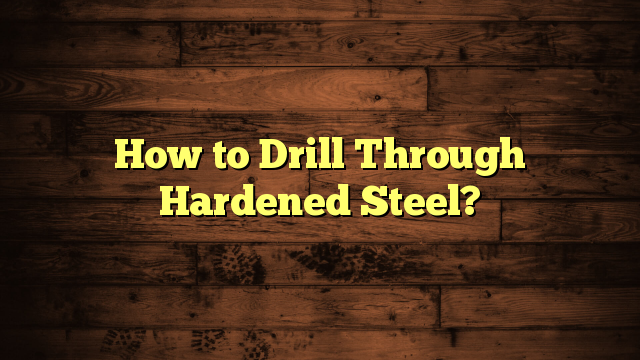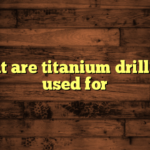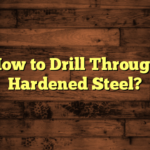Drilling through hardened steel may appear to be a difficult process, but with the correct equipment, skills, and understanding, it is not only possible but also rather enjoyable. Understanding how to drill through hardened steel is a vital skill for everyone interested in metalworking, whether they are DIY enthusiasts, mechanics, or metalworkers. In this post, we’ll look at the fundamental procedures and strategies for drilling through hardened steel while keeping your instruments’ integrity and obtaining exact results.
Understanding the Problem
Hardened steel, recognized for its remarkable strength and durability, offers difficulty due to its high Rockwell hardness rating. Drilling through this resistant material, which is commonly used in industrial machinery, tools, and construction applications, demands careful planning and execution. When attempting to pierce this tough material, typical drill bits that are not particularly developed for hardened steel may soon get dull, shatter, or chip.
Choosing the Best Tools
Drill Bits: For drilling through hardened steel, carbide or cobalt drill bits are the best option. These bits are made to endure the rigors of drilling into strong materials and keep their cutting blades sharp for longer periods. Carbide bits are well known for their toughness and ability to preserve sharpness even when subjected to intense heat during drilling.
Drill Machine: Choose a drill machine with variable speed settings. The variable speed feature allows you to vary the drilling speed based on the hardness of the steel. Drilling into hardened steel at slower rates is often suggested to avoid overheating and retain control.
Coolant or lubricant: Heat buildup can blunt the cutting edges of your drill bits while drilling into hardened steel. Using a metalworking lubricant or coolant may significantly reduce friction and heat, increasing the life of your tools and assuring cleaner holes.

Drilling Hardened Steel Step-by-Step Guide
- Marking and Centre Punching: To begin, use a center punch to indicate the location where you wish to drill. When you begin drilling, this generates a little depression that helps keep the drill bit from straying.
- Begin with a Small Pilot Hole: For bigger holes, it is best, to begin with a smaller pilot hole. This aids in the guidance of the bigger drill bit and lowers the possibility of the bit sliding or wandering on the steel surface.
- Set the Right Pace and Pressure: Start your drill at a modest pace. significant pressure might produce significant heat buildup and prematurely dull your drill bit. Allow the bit to do the work – consistent, uniform pressure is essential.
- Maintain a strong Grip: Keep a strong grip on the drill to keep it perpendicular to the surface. A minor tilt in the drill bit might cause it to bind or shatter.
- Cooling the Bit: If you’re drilling a larger hole or feel the bit becoming hot, pull it out and use a cooling lubricant to prevent overheating.
- Gradually Increase Hole Size: After drilling the pilot hole, gradually increase the drill bit size. This gradual approach decreases bit stress and lessens the chance of overheating.
- Maintain steady Speed: While increasing the bit size, keep the drilling speed steady. Too much speed can soon dull the bit, while too little speed might cause it to bind.
- Clearing Chips: Remove metal chips and debris from the hole regularly, since they might impede drilling.
Precautions for Safety
- Safety goggles are required to protect your eyes from metal shards and debris that may be generated while drilling.
- Wear a mask to avoid fine particle inhalation while drilling into stainless steel or other metals with possible health hazards.
- Gloves: Protect your hands from sharp edges and hot metal surfaces by wearing gloves.
Conclusion
Drilling through hardened steel needs time, the proper equipment, and a methodical technique. You may produce clean, accurate holes in even the toughest steel surfaces by using the proper drill bits, keeping the optimum drilling speed, and utilizing lubricants to prevent heat. Remember that safety comes first, so always wear the appropriate protective gear and proceed with caution during the drilling procedure.
FAQs
- What is hardened steel?
Hardened steel refers to steel that has undergone a heat treatment process to increase its strength and durability. This makes it much tougher and more resistant to drilling compared to regular steel.
- What type of drill bit should I use for hardened steel?
For drilling through hardened steel, you’ll need a high-speed steel (HSS) drill bit or a cobalt drill bit. Cobalt drill bits are even better suited for the task due to their higher heat resistance and hardness.
- What size of drill bit should I use?
The size of the drill bit depends on the hole size you need. Choose a bit that matches the diameter of the hole you want to drill.

This is Carter Greene, a 15-year lathe woodworking tools expert specially lathe tools, sharing invaluable insights and tips on a dedicated blog for woodworking enthusiasts.










